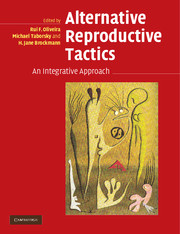Book contents
- Frontmatter
- Contents
- List of contributors
- Preface
- 1 The evolution of alternative reproductive tactics: concepts and questions
- PART I ULTIMATE CAUSES AND ORIGINS OF ALTERNATIVE REPRODUCTIVE TACTICS
- PART II PROXIMATE MECHANISMS OF ALTERNATIVE REPRODUCTIVE TACTICS
- PART III TAXONOMIC REVIEWS OF ALTERNATIVE REPRODUCTIVE TACTICS
- 8 Alternative reproductive tactics in insects
- 9 The expression of crustacean mating strategies
- 10 Alternative reproductive tactics in fish
- 11 Alternative reproductive tactics in amphibians
- 12 Alternative reproductive tactics in reptiles
- 13 Alternative reproductive tactics in birds
- 14 Alternative reproductive tactics in nonprimate male mammals
- 15 Alternative reproductive tactics in primates
- PART IV EMERGING PERSPECTIVES ON ALTERNATIVE REPRODUCTIVE TACTICS
- Index of species
- Subject index
- References
13 - Alternative reproductive tactics in birds
Published online by Cambridge University Press: 10 August 2009
- Frontmatter
- Contents
- List of contributors
- Preface
- 1 The evolution of alternative reproductive tactics: concepts and questions
- PART I ULTIMATE CAUSES AND ORIGINS OF ALTERNATIVE REPRODUCTIVE TACTICS
- PART II PROXIMATE MECHANISMS OF ALTERNATIVE REPRODUCTIVE TACTICS
- PART III TAXONOMIC REVIEWS OF ALTERNATIVE REPRODUCTIVE TACTICS
- 8 Alternative reproductive tactics in insects
- 9 The expression of crustacean mating strategies
- 10 Alternative reproductive tactics in fish
- 11 Alternative reproductive tactics in amphibians
- 12 Alternative reproductive tactics in reptiles
- 13 Alternative reproductive tactics in birds
- 14 Alternative reproductive tactics in nonprimate male mammals
- 15 Alternative reproductive tactics in primates
- PART IV EMERGING PERSPECTIVES ON ALTERNATIVE REPRODUCTIVE TACTICS
- Index of species
- Subject index
- References
Summary
CHAPTER SUMMARY
Birds, as one of the most-studied taxa among all organisms, have provided some of the best examples of alternative reproductive strategies and tactics. In this chapter, I first review the few cases where a genetic polymorphism has either been documented or is the most likely underlying cause for the alternative strategies observed. They range from the classic ruff example, where males either defend a territory as independents or try to obtain matings as nonterritorial satellites, to the different egg morphs described in the common cuckoo and plumage polymorphisms associated with different life-history strategies. In birds, commonly employed conditional strategies that increase fitness are intraspecific brood parasitism in females and extra-pair copulation behavior in males. Finally I discuss the interactions between the sexes, the influence these interactions have on strategies followed by one sex, and the importance of incorporating these interactions in future models. I also suggest reasons to explain why certain strategies, such as parasitic male reproductive behavior, are so rare in birds compared to other taxa.
INTRODUCTION
The evolution of alternative reproductive phenotypes is often believed to be associated with sexual selection (Neff 2001). Since the study of sexual selection and mate choice has figured prominently in ornithology over the last two decades (Andersson 1994), it comes as no surprise that a number of examples have been discovered in this taxon.
Gross's (1996) classification divides alternative reproductive phenotypes in birds into two groups.
- Type
- Chapter
- Information
- Alternative Reproductive TacticsAn Integrative Approach, pp. 343 - 355Publisher: Cambridge University PressPrint publication year: 2008
References
- 9
- Cited by



